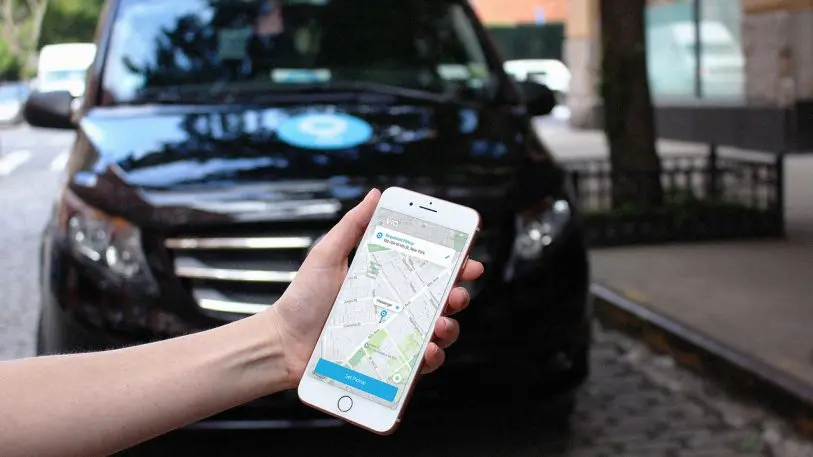The city of Arlington, Texas, is bigger, by population, than New Orleans, Cleveland, and Pittsburgh. It is home to a Six Flags, a state university, and the Dallas Cowboys’ home stadium. But Arlington, despite its size, did not have a public transit system—at least not until December 2017, when ride-pooling service Via began operating a network of on-demand six-seat vans. In so doing, the Texas municipality became one of dozens of cities to hire Via to provide “transit-as-a-service,” its public sector-friendly twist on the ride-hailing model.
“Access to things that people need for their daily lives was a major issue here,” says Lyndsay Mitchell, Arlington’s strategic planning manager. Now, residents can get across town by hailing a $3 seat through Via’s app. After spreading the news of its arrival in-person at the local Walmart and University of Texas-Arlington campus, Via completed 118,000 rides in its first year of service.
Within months of launching in Arlington, Via expanded its service area to include The Parks Mall, a local shopping hub. A few months later, the two partners renewed their contract. Long-term, Mitchell hopes to see Via operate citywide, across Arlington’s 99.7 square miles.
Elsewhere, relations between ride-hailing apps and local governments are far less cozy. Industry leaders Uber and Lyft have been accused of increasing accidents, congestion, and pollution; decreasing mass transit ridership; and threatening the livelihoods (and even the very lives) of taxi drivers. Last August, New York City became the first large U.S. city to impose a cap on the number of for-hire vehicles licensed to operate and voted to enforce a minimum wage for drivers.
Via has taken a friendlier route, positioning itself as a modern complement to existing transit systems, or an infrastructure-light, from-scratch solution for sprawling auto-ring cities like Arlington. Daniel Ramot, cofounder and CEO, describes Via as a “dynamic bus,” sitting somewhere between resource-hogging private cars and inflexible buses. “The idea was, can we come up with an intermediate solution that hits that right balance of cost and convenience,” he says.

The company also began decoding the behavioral quirks unique to ride-sharing. For example, people are much more sensitive to detours later in their route. “If the car takes you out of your way early on, versus when you’re just a block from your destination, that can be very frustrating, even it’s the same amount of detour,” he says. “So there’s a perception question.”
Over time, Via’s data collection has paid off. The company currently operates its own branded service in six locations, including Amsterdam, London, and Chicago, while licensing its software or providing “transit-as-a-service” to two dozen more municipal customers, from Bordeaux, France, to Singapore. In Berlin, for example, the company has teamed up with Berliner Verkehrsbetriebe, the city’s public transit authority, to manage a fleet that could grow to 300 vehicles. To fuel that growth in Berlin and globally, it has raised $387 million in venture capital, including a check from German automaker Daimler. This month, it passed a major milestone: 50 million global rides.
Of course, Uber and Lyft offer pooled rides, too. And, like Via, they argue that their apps serve as a critical extension of existing mass transit, bringing riders to and from far-flung bus and subway stations. But so far, Uber and Lyft are not pooling enough passengers to counteract their private rides. With Via, in contrast, 95% of rides are booked as shared, according to the company.
“There has to be enough pooling to offset the number of vehicles [added to the road],” says Gregory Erhardt, PhD, an assistant professor in the civil engineering department at the University of Kentucky. With pooling rates of around 20% or 30%, as suggested by passenger surveys, Uber and Lyft have yet to meet that benchmark. “A lot of it depends on how effective the matching is,” he says. “You have to request waits or walks, or else you backtrack and people get mad.” Make those walks more substantial, and “it starts to look like a local bus service.”
For Via, that’s exactly the idea–though it tries to keep the walks to a minimum. Thanks to city contracts, most of Via’s operations are subsidized by local transit budgets. Consumers pay whatever portion of the fare that the city feels is appropriate.
“In some cities, it really isn’t about profitability, necessarily,” Ramot says. “It’s about providing the right service that the city is interested in providing while achieving their goals and keeping the cost most efficient.” He adds: “This model, I think, could be profitable in any market. It’s just, if the city has 100,000 residents, you’re going to need a lot of them to be using the service. Your penetration has to be much higher.”
For now, though, he’s focused on growth. By the end of 2019, Ramot expects Via to operate in 200 cities worldwide. Most of those new markets will be using Via’s “transit-as-a-service” and looking to the ride-pooling company as a collaborator, rather than an adversary. “We have a lot of private cars that we need to get people out of,” he says. “We believe that dynamic shuttles are a really big part of that.”
Recognize your brand’s excellence by applying to this year’s Brands That Matter Awards before the early-rate deadline, May 3.
